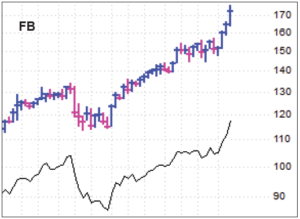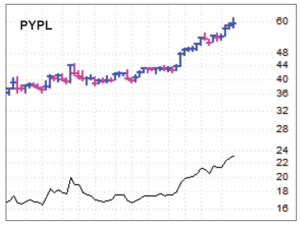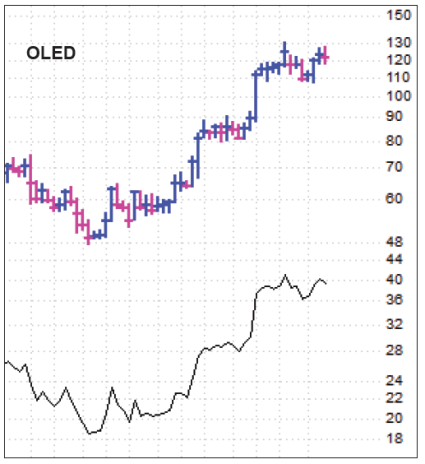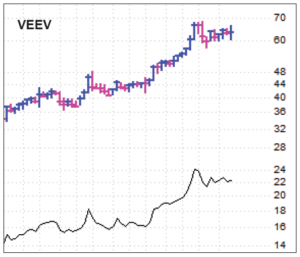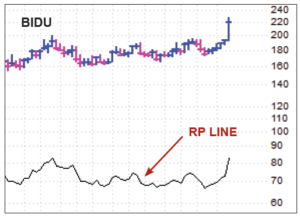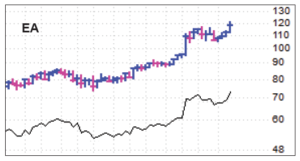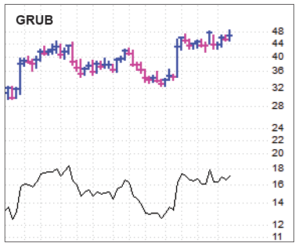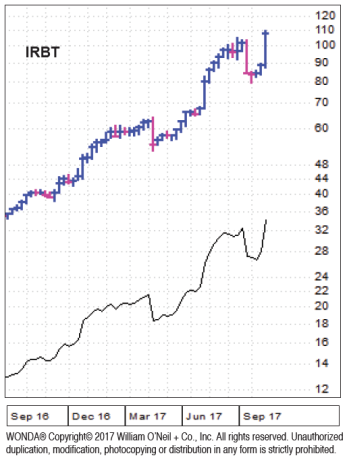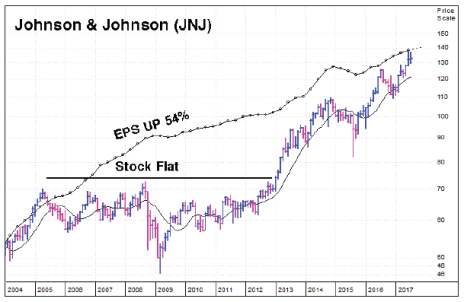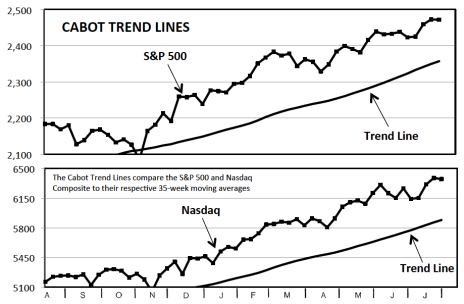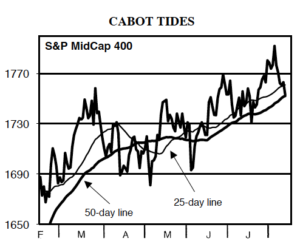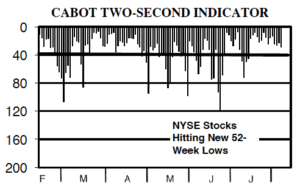In tonight’s Cabot Growth Investor, we review all our stocks and highlight some names we’re watching, including one that’s set up very well ahead of earnings. We also dive into some details about how we run our ship—we’ve gotten a few questions about this lately, and we think this will clear up any questions you may have.
Cabot Growth Investor 1373
[premium_html_toc post_id="136990"]
Good, Not Yet Great
From a top-down perspective, we can’t throw many stones at the market. The long-term trend is decisively up, as it has been since April 2016. The intermediate-term trend is up, too, with every major index having kissed all-time highs during the past week or two. And even the broad market has gotten its act together, as our Two-Second Indicator is positive and the advance-decline line is hitting new highs.
Individual growth stocks are also doing well, though there are a few more “buts” thrown in. For instance, a handful of liquid leaders did hit new highs soon after the market’s rally started in March, but few have made much progress. A lot of other growth stocks rallied nicely in July, but most have stalled out near their old highs. And we see a lot of good setups, but most of those stocks are reporting earnings in the days ahead.
We see some of this good-not-great action from growth stocks reflected by the relative performance (RP) line of the Nasdaq versus the Dow (see chart below). After a strong upmove all year, the RP line has stalled out a bit since early June, a sign that investors are more interested in steadier, dividend-paying stocks than the growth stocks usually found on the Nasdaq.
None of this is meant to paint an overly cautious picture. On the contrary, we’re 80% invested in the Model Portfolio, and most of our stocks are acting well. In fact, coming into this week, the Model Portfolio is up a couple of percent from its early-June levels, which is a good sign that we (and growth stocks in general) are still on track.
Thus, we’re aiming to get fully invested, but we want to see a bit more strength in growth stocks before taking the plunge.
From here, the plan is simple. First, we’re keeping an eye on our stocks as they release earnings; so far, three have reported (good results), but two more come tomorrow, with another two later this month. And second, we’re looking for stocks we don’t own (including those on our Watch List) to show some real upside power as a signal to grab shares.
[highlight_box]WHAT TO DO NOW: For now, we’re content to stick with our current crop of eight stocks and cash position of around 20%. Tonight, XPO Logistics (XPO) is being placed on Hold because the stock has faded, and will take my cues from the individual growth stocks going forward.[/highlight_box]
Model Portfolio Update
We’re smack-dab in the middle of earnings season, and so far, things have gone relatively well, with all three Model Portfolio stocks that have reported (Facebook, PayPal and, yesterday, Shopify) reacting well, at least initially. That said, there are more reports to wade through, including XPO Logistics and Universal Display tomorrow. As always, the reaction to the news (not just initially but in the days that follow) is what counts.
As for putting our cash to work, we’re more than willing, but we’ve seen few liquid leaders lift to new highs during this rally, and those that have pushed only modestly higher. As we wrote in last week’s update, we want to get “pulled” into a fully invested position by jumping on stocks that are on the upswing. Thus, if earnings season results in some new leaders, we’re game, but until then, keeping a small cash position makes sense.
Current Recommendations
BUY—Alibaba (BABA 152)—Alibaba has been relatively quiet on the news front lately, though one item that’s making some waves is the ongoing saga over Ant Financial’s (a huge payment firm that has a profit sharing agreement with Alibaba) effort to acquire MoneyGram; Ant had to resubmit its offer to U.S. regulators, who are reportedly frowning on allowing another big Chinese takeover. Still, for BABA, it’s not a huge matter—investors are focused on the company’s core e-commerce opportunities, as well as its small but rapidly growing cloud business. As for the stock, it has hit some resistance in the high 150s lately, but the trend is clearly up and earnings (no set date yet, but likely in a week or two) will tell the intermediate-term tale. Short-term, then, there’s risk, especially given the fact that BABA hasn’t had much of a pullback all year. But the big picture (including its breakout in May from its huge post-IPO consolidation) points to higher prices down the road. We’ll stay on Buy, but new buyers should keep positions on the small side with earnings out soon.
BUY—Facebook (FB 169)—Facebook’s amazing growth story continues, as its second-quarter report revealed last week. Mobile ad revenue leapt 53% from the prior year, total revenue grew 45% and earnings of $1.32 per share rose 69%, easily topping expectations. Some other figures from the conference call: 70 million businesses now have Facebook pages (and 15 million are now on Instagram); June saw 1.32 billion users on average per day; and the average price per ad grew 24% while ad impressions grew 19%. The top brass again cautioned that expenses are likely to grow meaningfully going forward, but that’s getting to be old hat—analysts significantly hiked their earnings estimates and are now looking for a huge 52% gain in the bottom line this year. (Next year’s estimates assume just 22% growth, which is something to keep an eye on.) FB reacted by gapping to new highs—short-term, it’s extended to the upside, so if you don’t own any, keep any new position on the small side or try to buy on a dip of three or four points. If you own some, though, just sit tight, as the major trends of the stock and the business are both pointed up.
BUY—PayPal (PYPL 59)—PYPL released an excellent quarterly report last week, with pretty much every metric showing solid growth and topping expectations. Sales rose 18%, earnings were up 28%, total payment volume of $106 billion in the quarter (!) gained 26% while free cash flow was up 51%; management responded by hiking guidance across the board. (Encouragingly, free cash flow should now total at least $2.40 per share this year, way ahead of reported earnings.) Just as encouraging, PayPal continues to ink deals with financial titans, which convey the message that competition is lessening—the latest deal was with Bank of America, which will allow the linking of PayPal and BofA accounts, allowing customers to effectively pay with their PayPal accounts via a BofA Visa or MasterCard. As for the stock, earnings ended up being mostly a non-event, as shares popped briefly before pulling back. But the trend is up and the stock only recently (late-April) got going from its post-IPO structure. Hold on if you own some, and if you don’t, you can buy some here or on dips of a point or two.
BUY—ProShares Ultra S&P 500 Fund (SSO 93)—We wouldn’t rule out anything when it comes to the market’s short-term future, whether it’s a late-summer decline, a sideways consolidation or an acceleration of the uptrend. But with SSO, our focus is on the intermediate to longer term, and whether you’re examining the trend of the S&P 500 (up), some of the second-half studies we examined two issues ago (a strong first six months almost always leads to a strong back half of the year), or various “blast-off” indicators that flashed earlier this year, the odds continue to favor a higher market in the months ahead. Thus, we’re just sitting tight with our shares at this point; if you want in, you can buy some around here or (preferably) on dips of a couple of points.
HOLD—Shopify (SHOP 98)—We’re not sure SHOP is ready to run yet, but Tuesday morning’s quarterly report certainly helped the cause—Shopify’s second-quarter revenues rose 75%, which was well above expectations, while the firm’s monthly recurring revenue rose 64% and gross merchandise volume through its e-commerce platform totaled $5.8 billion, up 74%. Even the loss (a penny per share) came in above estimates. Perhaps most encouragingly, the firm had another record quarter of client growth—it now serves more than 500,000 merchants, which is up at least 33% from the start of the year, with strong growth seen across the globe, and 131 million people have bought from Shopify stores during the past 12 months. The stock popped nicely on the news, though we can’t decisively say that SHOP is ready to run; after today’s action, it’s hanging around its old high near 100. (The relative performance (RP) line is doing the same thing.) We’ll stay on Hold and see how things play out.
BUY—Universal Display (OLED 120)—Universal Display is releasing its quarterly report tomorrow (Thursday, August 3) evening, which will probably be a make-or-break event for the stock. Obviously, we’ll be looking at the headline numbers and any guidance for the rest of the year, but we’ll also be interested in any updates management has on its customer activities—in the first quarter’s conference call, the top brass detailed various reports of billions of dollars of investment from Samsung and LG (which combine to make up most of Universal’s business) and others, including forecasts from LG’s technology experts that they expect OLED TV production capacity to rise six-fold from 2016 to 2020. Details aside, we’ll just take what the stock gives us—a plunge below the 100 to 105 area would make the chart look toppy and likely have us selling, but otherwise, we’re aiming to hang on and play the multi-year organic light emitting diode boom. We’ll stay on Buy right now because the stock acts fine, but will send updates if need be after the report.
HOLD—Veeva Systems (VEEV 62)—VEEV looked pretty dicey last Thursday, when it briefly plunged below its 50-day line on heavy volume, but it’s since steadied itself. There’ve been no news stories, rumors, reports or anything else about the company in recent weeks, and earnings aren’t likely to be released until around month-end. We continue to think Veeva’s CRM and Vault product lines have a very long runway of growth, with years of 25% to 30% growth (and very high profit margins) likely. But we’ll just follow our plan when it comes to handling the stock—a dive below the 57 to 58 area would have us selling and looking for better opportunities, but a decisive push above 68 could be the “go” signal after a two-month rest. For now, though, we’ll stick with our Hold rating as we wait for the stock to reveal its next big move.
HOLD—XPO Logistics (XPO 59)—XPO Logistics is being switched to Hold today because the stock has turned sluggish since pricing a good-sized share offering last week. (Some horrid performance from transport stocks hasn’t helped, either.) Still, the longer-term chart is far from a disaster—the stock is off about 10% from its high and remains above its breakout level in the 55 to 56 area, which is right around our line in the sand. Like many stocks, XPO’s intermediate-term path will likely come down to tomorrow morning’s (August 3) quarterly report and (importantly) conference call, which, along with updates on the free cash flow outlook for the rest of the year, should give big investors insight into what CEO Bradley Jacobs has in mind for the money the firm just raised. If you own some, hang on, but as always, we’ll update you with any changes in advice going forward.
Watch List
Carvana (CVNA 19): CVNA remains very thinly traded and has recently backed off, but the action is normal following its huge run. Earnings are due out on August 8.
Celgene (CELG 135): CELG is chopping around after its huge-volume thrust higher in June. It’s not going to triple, but we think shares can do very well if biotech stocks confirm their recent upmove.
GrubHub (GRUB 47): GRUB is still within a gigantic consolidation dating back to March 2015, but earnings (due out tomorrow) could change that. See Other Stocks of Interest.
ServiceNow (NOW 107): NOW has been jerked around a bit post-earnings, mostly due to the retreat in the Nasdaq. But the chart is still OK and the story looks fine to us—a move above 114 or so would be tempting.
Other Stocks of Interest
The stocks below may not be followed in Cabot Growth Investor on a regular basis. They’re intended to present you with ideas for additional investment beyond the Model Portfolio. For our current ratings on these stocks, see Updates on Other Stocks of Interest on the subscriber website or email mike@cabotwealth.com.
Baidu (BIDU 222) — Baidu, despite its trials and travails, is still the biggest online search engine in China, and the stock is showing signs of picking up some speed after one of the longest base-building phases we’ve seen. BIDU hit its all-time high of 252 in November 2014, and spent 31 months trading in a tightening range. That’s understandable, as Baidu hasn’t been as nimble as online giants like Alibaba and Tencent Holdings in making the switch to mobile devices and 2016 revenue was up just 1%. But the company’s Q2 earnings report showed a 12% jump in revenue and an impressive 93% hike in earnings. BIDU, which had already broken above its tightened trading range, responded with a high-volume blastoff from 205 to 225 and is holding those gains pretty well. BABA is the stronger stock, but BIDU, with earnings estimates running at 20% growth for this year, could be an interesting turnaround candidate.
Electronic Arts (EA 117) — Electronic Arts is a video game software developer whose games are played on consoles, PCs, hand-held platforms and mobile phones. The company boasts a bunch of franchises like Madden NFL, FIFA, Star Wars, The Sims and Battlefield that book big sales around the globe with every update. The company reported results on July 27 and investors loved the revenue and earnings numbers, but were a little put off by second-quarter forecasts. But with free cash flow of $143 million in the quarter and operating cash flow of $1.87 billion over the previous 12 months, Electronic Arts is a good long-term bet. The company’s repurchase of $150 million of its own stock (with an additional $1.08 billion in buybacks still authorized) is a nice bonus.
GrubHub (GRUB 47) — GrubHub, a leader in online and mobile takeout and delivery food ordering, has been a tricky stock to handle. On one hand, revenue growth has been excellent (36% in 2016 and 39% in Q1) and the company has added 50,000 new restaurants to its service, including Chili’s, Maggiano’s and initial rollouts with Subway, Buffalo Wild Wings, Denny’s and others. On the other hand, GRUB went over the falls in 2015, then rebounded to near its old highs in August 2016 and still faces long-term resistance in the high 40s. There may be a moment of truth coming, as the company will report its Q2 results tomorrow (August 3) after the market closes. Analysts are looking for revenue just over $158 million and earnings of 26 cents per share. This is a fiercely competitive industry, but with a huge, mass market story and a history of strong growth, any decisive breakout from GRUB could kick off a sustained rally.
iRobot (IRBT 104) — iRobot is the designer and marketer of smart gadgets like the autonomous Roomba vacuuming robot and Braava jet mopping robot. RBT has been in an uptrend since early 2016, and after a correction from 100 to 80 in late June, the stock rebounded on high volume, regaining the 100 level and holding its gains. A strong Q2 earnings report on July 25 had a big hand in that recovery, as results were well ahead of expectations and the company increased its full-year 2017 estimates. IRBT is a little too volatile right now, but if it can settle down above 100 for a while, it will be well worth watching.
How We Run Our Ship
Some new and recent subscribers have recently asked how we operate Cabot Growth Investor, and since we haven’t reviewed how we run our ship in a long time, now’s a good time to dive in.
Buy and Sell Prices: We use the average of the stock’s high and low on the following day. Thus, if we recommend selling XYZ on our Wednesday evening update, our official sell price will be the average of Thursday’s high and low, which we think is a good representation of the “average” subscriber’s price.
Time of Day to Buy: There’s no one time of the day that’s best to act on a new recommendation (buy or sell). However, we would advise against entering an order overnight to buy at the open—oftentimes you’ll end up buying on a brief pop when the market opens. Instead, pick a time of day that you usually have free and do your buying or selling at that time. Consistency is key.
How Much to Invest in a New Recommendation: We have 10 “slots” in the Model Portfolio, and we generally try to invest the same amount (dollar-wise) in each new recommendation. We let the stocks themselves tell us which ones are likely to be the big winners. As for the money, we simply take our cash on hand and divide it by the number of “empty slots” in the Portfolio, which gives us the amount to invest—so if we have $30,000 on the sideline and three empty slots, we would invest $10,000 in a new Buy.
Is the Model Portfolio real? No, it’s a Model. However, we do track our results each week, and we do have money invested in many of our recommended stocks (as well as in stocks from other Cabot advisories). So we’re not just writing about stocks—we’re feeling the joys and heartache along with everyone else.
On High Priced Stocks: Definitely one of our most common questions, we almost always ignore the price of a stock unless it’s over 500 per share. The reason: Many high-priced stocks go a lot higher, as we’ve seen with Google, Amazon, Facebook and the like. What matters isn’t how many shares you own, but how many dollars you have invested. A high-priced stock (if it’s a winner) will moves many, many more points than a low-priced stock, which will make it worthwhile even if you only have a few shares. Many of our biggest winners over time have started around 100 and gone a lot higher.
Should You Buy Our Long-Time Holdings? Sure, if they’re rated Buy. We keep big winners in the Model Portfolio because the long-term trend of the stock (and the business) remains up, and because we see plenty of potential going forward. If that’s not the case, we’ll rate the stock Hold or, eventually, Sell. Facebook is a classic example: We’ve owned it since July 2013, but it continues to act well and has all the potential in the world, so why avoid it?
So I can buy any Buy-Rated Stock Right Now? Strictly speaking, yes, if something’s rated Buy, it can be bought. But in most cases, it’s best to try to buy on dips, or after a couple of bad market days, that sort of thing. If you have specific questions, don’t hesitate to email me at mike@cabotwealth.com.
The Company is Not the Stock
When stocks hit turbulence in June and July, we were asked many times whether XYZ stock was “still a good company” and whether “the story was intact.” Well, our answer was usually yes—but that it didn’t matter! What mattered was whether the stock was acting properly (which tells you big investors still think highly of the company).
Sales and earnings trends are important, but they don’t come close to guaranteeing a stock’s success, even in the long run. We could pull up dozens of examples proving this point—Google, for example, went nowhere from the start of 2010 through the middle of 2012, during a bull market, even though its earnings rose nearly 50% during that time.
It happens to blue chips, too. Look at this monthly chart of Johnson & Johnson (JNJ), one of the best-run companies in the world. The stock hit a peak of 70 in early 2005, and except for a brief blip above there in mid-2008, didn’t decisively lift above that level until 2013. During that time, the S&P 500 was up 23%, and JNJ’s own earnings rose a total of 54% (and rose nearly every quarter, too!). Since then, the firm’s earnings have risen “only 37%” but the stock is up 88%.
The bottom line is that you’re better off putting your faith in a stock’s overall action—not reacting to every wiggle, but staying in gear with the major trend. If the trend is up, it’s telling you that big investors still think highly of the company, which is all you really need to know.
Cabot Market Timing Indicators
From a top-down point of view, the overall market looks fine, so we’re staying heavily invested. That said, individual growth stocks have been just OK, so we’re still holding some cash and waiting for more leadership to emerge.
Cabot Trend Lines: Bullish
Our Cabot Trend Lines remain in fine shape, with the S&P 500 (by 4.9%) and Nasdaq (by 8.2%) closing last week comfortably above their 35-week moving averages. At some point, the major indexes will have a meaningful correction and crack their longer-term uptrend, but until then, it’s best to just go with the evidence, which continues to tell us that it’s a bull market.
Cabot Tides: Bullish
Our Cabot Tides also remain on the positive side of the ledger—the big-cap indexes (Nasdaq, NYSE Composite and S&P 500) are in the best shape, though even small- and mid-cap indexes (including the S&P 400 MidCap, shown here) have dipped back to their 50-day lines. A couple of bad days could change the picture, but as always, we just go with the evidence at hand, which today is telling us that the market’s major trends are pointed up.
Two-Second Indicator: Healthy
The Two-Second Indicator seems to be finally getting in gear after a couple of months of on-again, off-again readings. The number of new lows was fewer than 40 for 15 straight trading sessions before today, a clear sign that the broad market is getting its act together and that, despite some waves of selling, the market’s underpinnings are in good shape.
[premium_html_footer]
Send questions or comments to mike@cabotwealth.com.
Cabot Growth Investor • 176 North Street, Post Office Box 2049, Salem, MA 01970 • www.cabotwealth.com
All Cabot Growth Investor’s buy and sell recommendations are made in issues or updates and posted on the Cabot subscribers’ website. Sell recommendations may also be sent to subscribers as special bulletins via email and the recorded telephone hotline. To calculate the performance of the portfolio, Cabot “buys” and “sells” at the midpoint of the high and low prices of the stock on the day following the recommendation. Cabot’s policy is to sell any stock that shows a loss of 20% in a bull market (15% in a bear market) from our original buy price, calculated using the current closing (not intra-day) price. Subscribers should apply loss limits based on their own personal purchase prices.
Charts show both the stock’s recent trading history and its relative performance (RP) line, which shows you how the stock is performing relative to the S&P 500, a broad-based index. In the ideal case, the stock and its RP line advance in unison. Both tools are key in determining whether to hold or sell.
THE NEXT CABOT GROWTH INVESTOR WILL BE PUBLISHED AUGUST 16, 2017
We appreciate your feedback on this issue. Follow the link below to complete our subscriber satisfaction survey: Go to: www.surveymonkey.com/marketlettersurvey
Neither Cabot Wealth Network nor our employees are compensated by the companies we recommend. Sources of information are believed to be reliable, but are in no way guaranteed to be complete or without error. Recommendations, opinions or suggestions are given with the understanding that subscribers acting on the information assume all risks. © Cabot Wealth Network. Copying and/or electronic transmission of this report is a violation of U.S. copyright law. For the protection of our subscribers, if copyright laws are violated, the subscription will be terminated. To subscribe or for information on our privacy policy, call 978-745-5532, visit www.cabotwealth.com or write to support@cabotwealth.com.
[/premium_html_footer]




